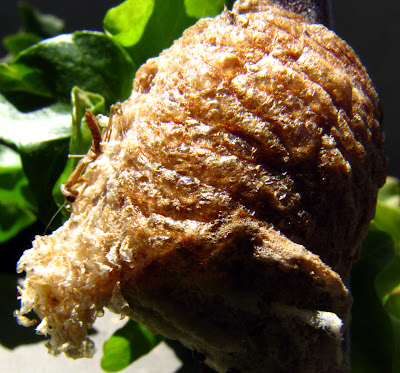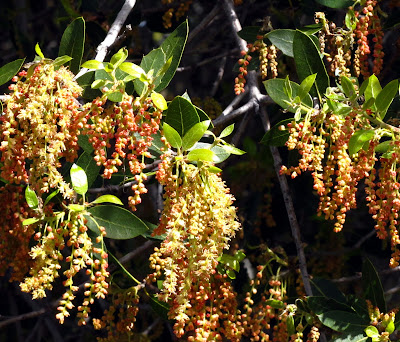Easily the most-used small tree in my repertoire is Arbutus 'Marina' a hybrid of our native Madrones. This was the first thing I planted in my last garden, and in four years that small shrub became this shapely specimen, with peeling red trunks, clean evergreen foliage and a long season of bloom. I also use it extensively in the standard form, and would love to see it used more as a street tree.
One of my favorite groundcovers under Arbutus is Elijah Blue Fescue (Festuca glauca). It appreciates a little shade and water to look its best; and makes a wonderful 18" mound of blue that is tough, soft, and looks great year round.
A good companion to blue fescue in a grassy landscape is the lovely Carex testacea. Its blades shift from olive green to coppery orange and back again throughout the year. This one will reseed freely if you don't keep its long flowing seed stems trimmed; you've been warned!
Soft, friendly Coleonema 'Sunset Gold' looks great planted near orange sedge; its golden plumes (and in the spring, small pink flowers) are a bright spot in any garden; it needs sun for best color.
A relatively new addition to my palette is Dianella; I use several varieties, like this Dianella caerulea (Blue Flax Lily). It's wonderful in a pot and happy in those spots that aren't quite sun and not full shade. The little blue flowers on airy stems are charming.
Somewhere in the background of my gardens you might find Dodonea purpurea (Purple Hopseed Bush). I adore the deep burgundy of the leaves in winter, and the graceful shape of the leaves and stems. They tend to be a little shallow-rooted and can tip over in wet/windy weather; firmly staking them until they are past their youth will keep them safe. In time makes an interesting small tree.
I really appreciate plants that look great in winter and early spring, when the rest of the garden is resting. Euphorbias, like this "Helena's Blush" fill the bill nicely. I would use them even more if they didn't smell, well, stinky. Ah well, nobody's perfect!
Except, just maybe, Nandina 'Firepower' a short, large-leafed variety that is simply gorgeous all year round. Happiest in part shade, with just enough sun to bring out the peach, red and copper tones in the leaves. Doesn't need much water, stays compact, with no pests to speak of.
Another contender for little Mr. Perfect is this variety of Pittosporum tenuifolium called "Golf Ball." Naturally neat and compact, looks shiny perfect all year round with little or no pruning. Those black stems and soft green leaves are killer, and if I were to make a small hedge, THIS is what I would use...
...not this. I am not a fan of boxwood usually, but this is my bright, shining exception. I like to dot variegated English Boxwood around a landscape (often zig-zagging along a path at wide intervals). Their leaves have a particularly luminous quality that just lights up the place, especially in shade. It is slow growing, tough, and needs only an occasional pinch (never sheared, thank you) to look great.
And of course, Succulents are like sprinkles for the landscape...bright, colorful, sculptural, undemanding and now available in SO many varieties that the possibilities are endless. They are often that perfect missing color or texture, especially in dry corners.
So now you know my short list...but don't stop here! My fellow Garden Roundtablers are spilling their secrets too, including guest blogger Nan Ondra; such an honor to have her here today. Enjoy!
Nan Ondra : Hayefield : Bucks County, PA
Andrew Keys : Garden Smackdown : Boston, MA
Christina Salwitz : Personal Garden Coach : Renton, WA
Genevieve Schmidt : North Coast Gardening : Arcata, CA
Ivette Soler : The Germinatrix : Los Angeles, CA
Jocelyn Chilvers : The Art Garden : Denver, CO
Lesley Hegarty & Robert Webber : Hegarty Webber Partnership : Bristol, UK
Rebecca Sweet : Gossip In the Garden : Los Altos, CA
Rochelle Greayer : Studio G : Boston, MA
Susan Morrison : Blue Planet Garden Blog : East Bay, CA











































